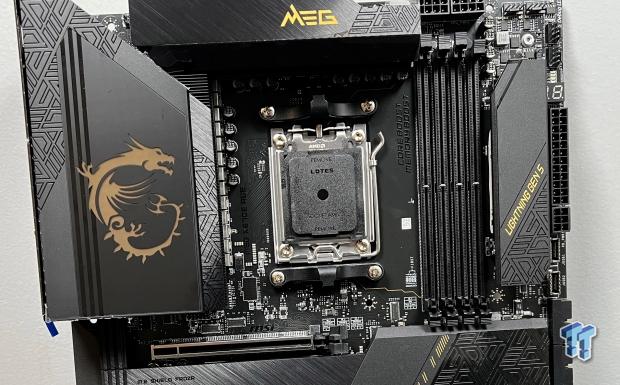
The Bottom Line
Pros
- + DDR5/PCIe 5.0
- + 10Gbe networking
- + Stacks of USB
- + Wi-Fi 6E
Cons
- - Price
- - No USB4
- - No HDMI
- - No DisplayPort
Should you buy it?
AvoidConsiderShortlistBuyIntroduction, Specifications, and Pricing
The Extreme Gaming or "MEG" lineup from MSI is surprisingly thin this generation, with the AMD X670E chipset seeing the light in the ACE and GODLIKE only. While this slims the available options for consumers wanting to build their own enthusiast-class machine, MSI has gone all out on these two boards, making both solutions flagship options.
Board specs include the base configuration with the AM5 socket and support for DDR5 memory. Memory support is pushed over four slots, has 128GB peak capacity, and is compatible with speeds ranging from 4400MHz to 6666MHz+ if you are inclined to overclock.
Expansion on this board includes three PCIe x16 slots, all pulling from the CPU with Gen5 support. That said, there are lane assignments when multiple slots are used. All slots populated give us an x8x8x4 assignment and x16x0x4 when the top slot is in use. Storage gets Gen5 support, too, with slot M.2_1 being the lone slot. There are an additional three m.2 slots that pull from the chipset at Gen4. Legacy storage is available as well, with six SATA ports available.
Connectivity on this board is quite interesting, starting with 10Gbe from Marvell AQC113, which is only part of the network stack, the other half being WiFi6e. USB connectivity includes eleven ports on the rear I/O, eight of these ports are type-A Gen2 ports, while the other three are Type-C supporting Gen2 and the other two support Gen2x2.
Pricing
The MSI MEG X670E ACE pricing comes in at $799.99 with a three-year warranty.

Packaging, Accessories, and Overview
Packaging and Accessories
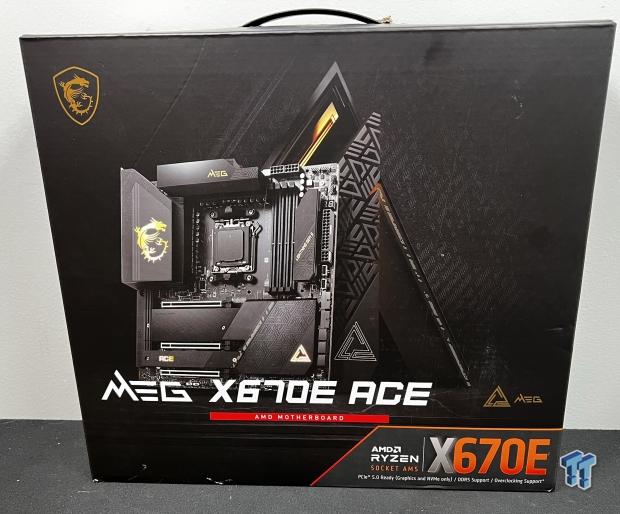
The ACE appears to keep the black and gold colorway in this new iteration, the box offering a peak at the board. Along the bottom, we note chipset and CPU support.

On the back, we get an image of the board to the left, with many features showcased on the right side.
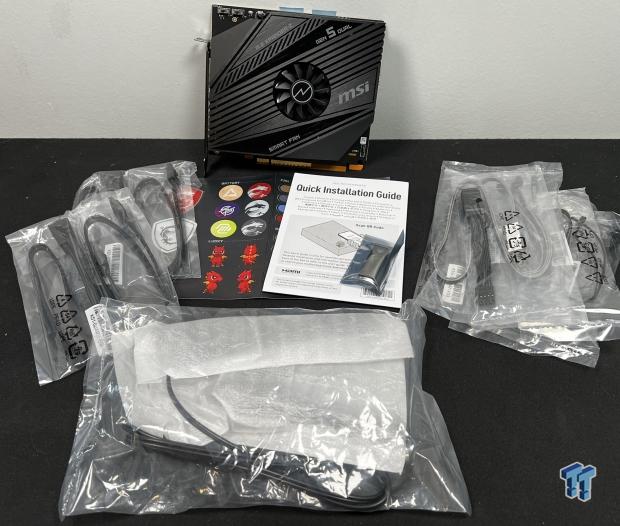
Included with the board is the Wi-Fi Antenna, M.2 expander, reading materials, and several other cables.
Motherboard Overview
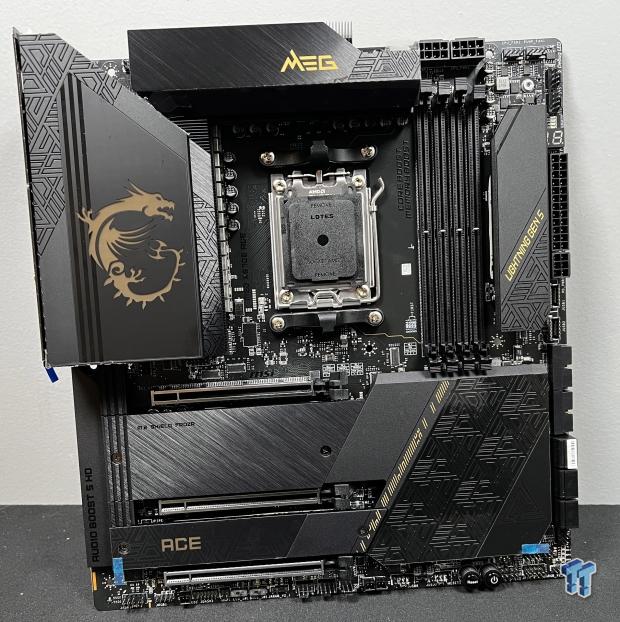
The ACE keeps the gold and black colorway used in the last few generations. It is a heavily heatsinked board, so it does have weight to it. This is the first board we have tested to push the main m.2 slot to the right of the memory slots.
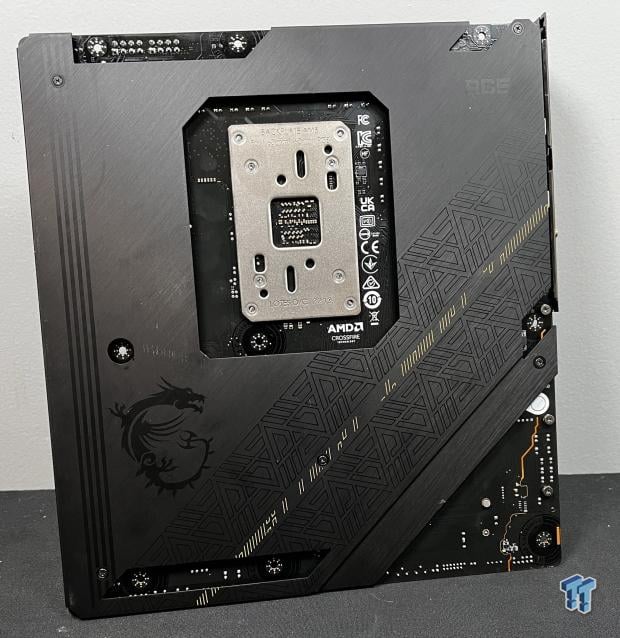
On the backside, we have a full backplate.

The rear I/O includes a stack of buttons at the top for CMOS reset, BIOS flashback, and a smart button. Further down, we have the first USB-C, doubling as Display Out for the integrated GPU. We then run into a mess of USB 3.2 ports, all at 10Gbps. Further down, we run into SMA antenna connections along with analog and digital audio.
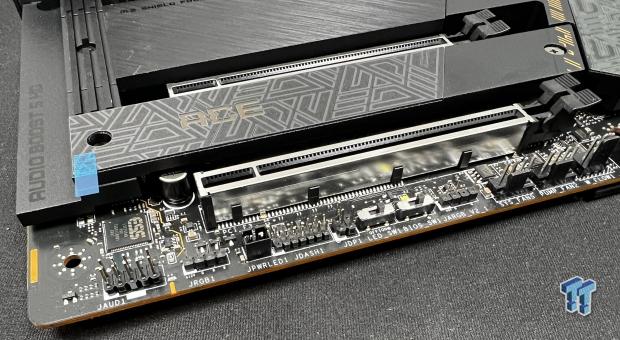
Running around the internal connectivity of this board, we have front-panel audio starting things off, followed quickly by RGB connections and fan headers.
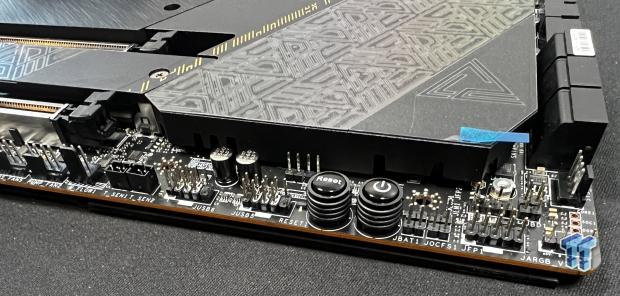
On the far end, we pick up the power and reset buttons, followed by front panel chassis connections.
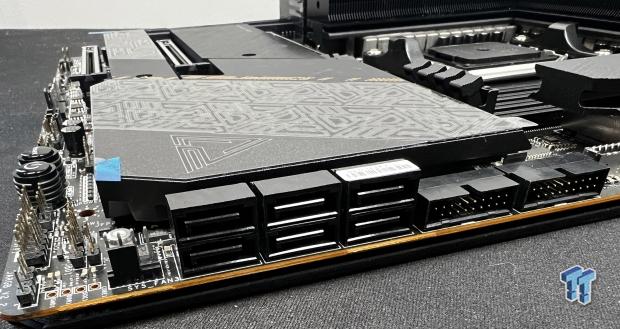
Around the corner, we have six SATA connections with dual USB 3.2 internal headers on the far right.
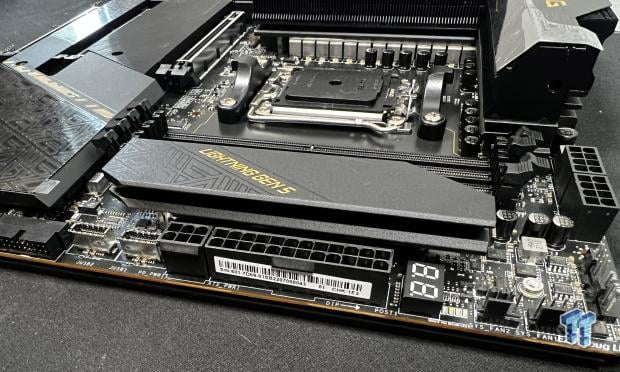
Getting to the top of the board, we have both 6-pin and 24-pin connections.
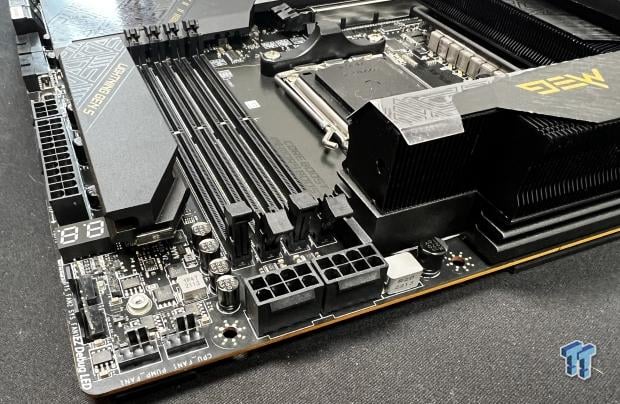
Across the top of the board, both 8-pin CPU connections have been moved to the right-side corner.
UEFI, Software and Test System
UEFI
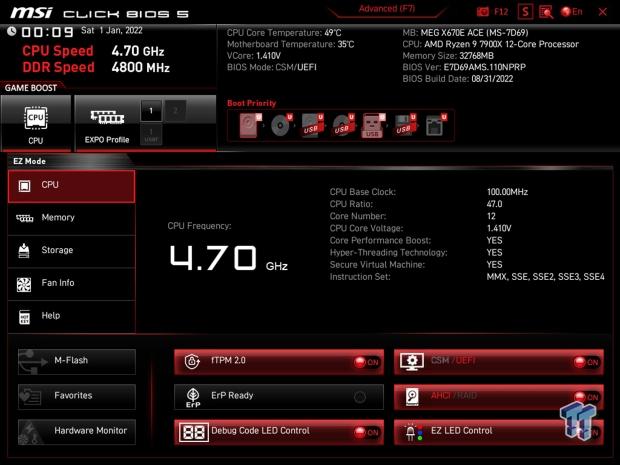
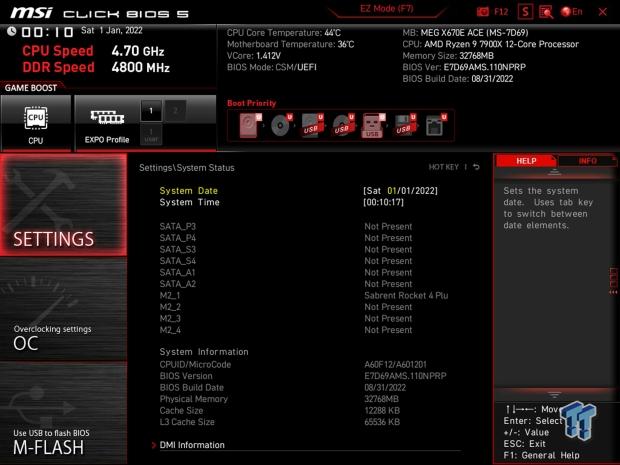
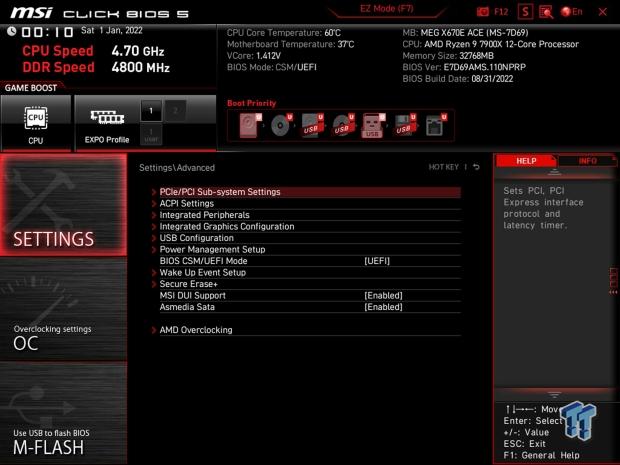
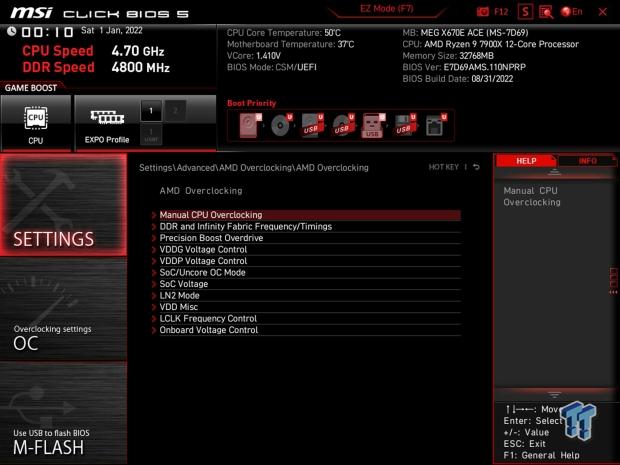
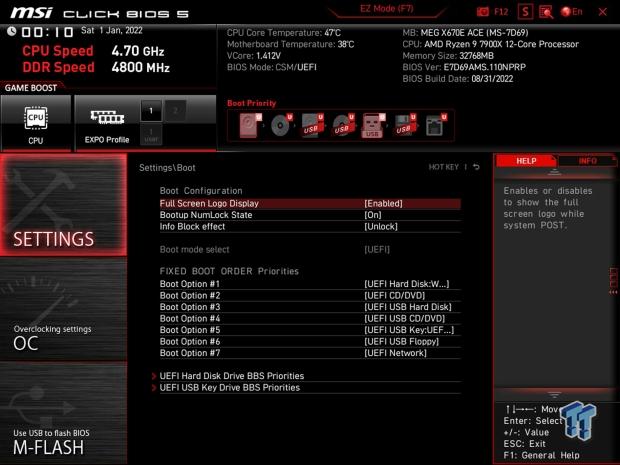
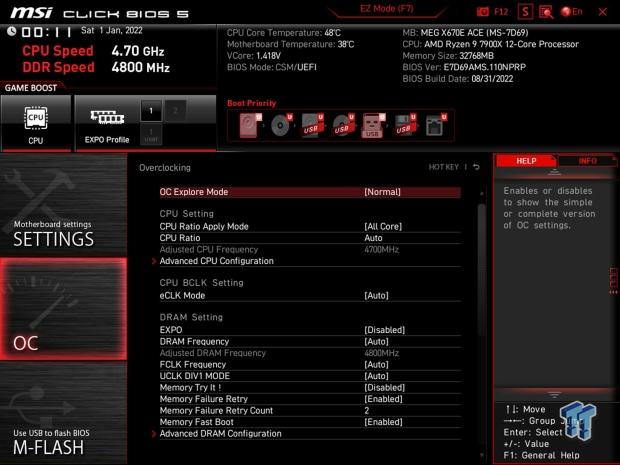
MSI's Click BIOS has stayed with X670E boards, giving consumers a familiar interface when tuning their new Zen 4 system. EZ Mode includes a complete overview of the board with abilities to enable EXPO, change boot order, etc.
Further menus include the settings menu allowing configuration of integrated devices, including iGPU, if your CPU has it. At the bottom of the menu, you can move into overclocking options. These include both manual tuning and PBO2 plus Curve Optimizer.
Motherboard Software
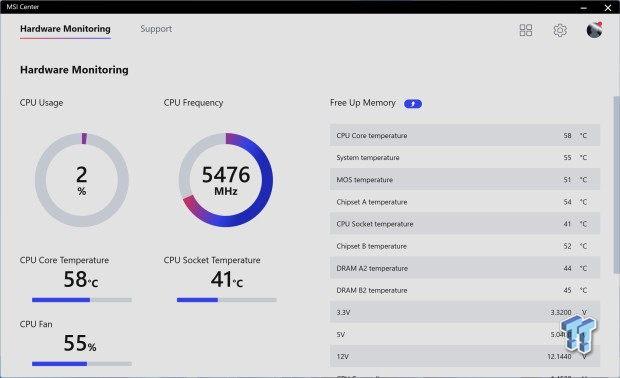
The software for this board is MSI Center, which allows you to monitor CPU usage alongside temperatures.
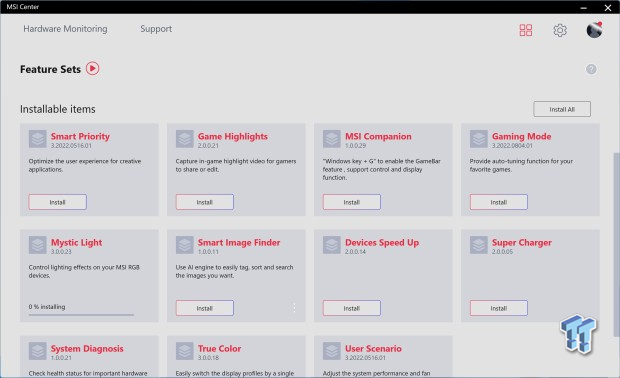
In addition, you can add modules to MSI Center.
Motherboard Testing Supporters
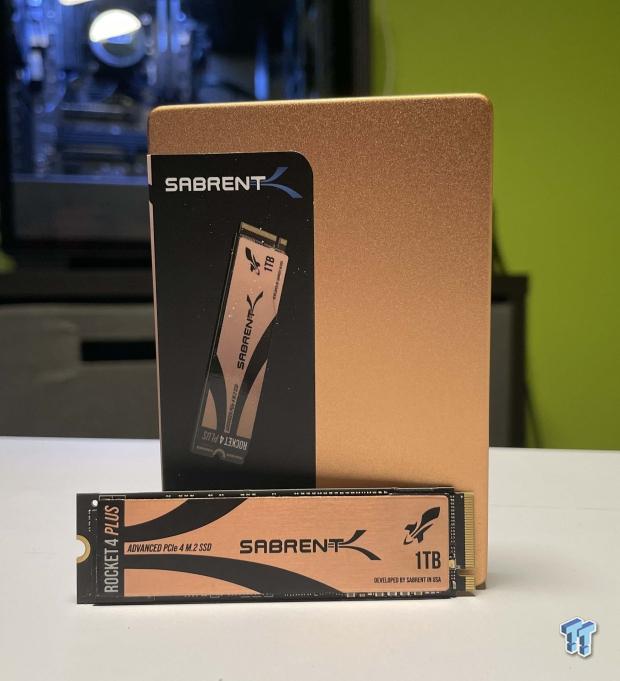
Sabrent supports our storage testing with the Rocket 4 Plus.
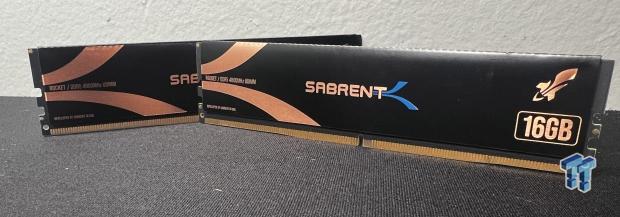
We crank up a set of Sabrent DDR5 for our testing, running DDR5 6000MHz at CL30 with 1.4v.
AMD Motherboard Test System
- CPU: AMD Ryzen 7 7700X
- RAM: Sabrent Rocket DDR5 4800MHz 32GB CL30 (buy from Amazon)
- GPU: NVIDIA GeForce RTX 3090Ti (buy from Amazon)
- OS Storage: Sabrent Rocket 4 Plus 1TB (buy from Amazon)
- Power Supply: AORUS P1200W PSU (buy from Amazon)
- OS: Microsoft Windows 11 (buy from Amazon)
Cinebench R23,Crossmark and AIDA64
Cinebench R23
Cinebench is a long-standing render benchmark that has been heavily relied upon by both Intel and AMD to highlight their newest platforms during unveils. The benchmark has two tests, a single-core workload utilizing one thread or 1T and a multi-threaded test that uses all threads or nT of a tested CPU.
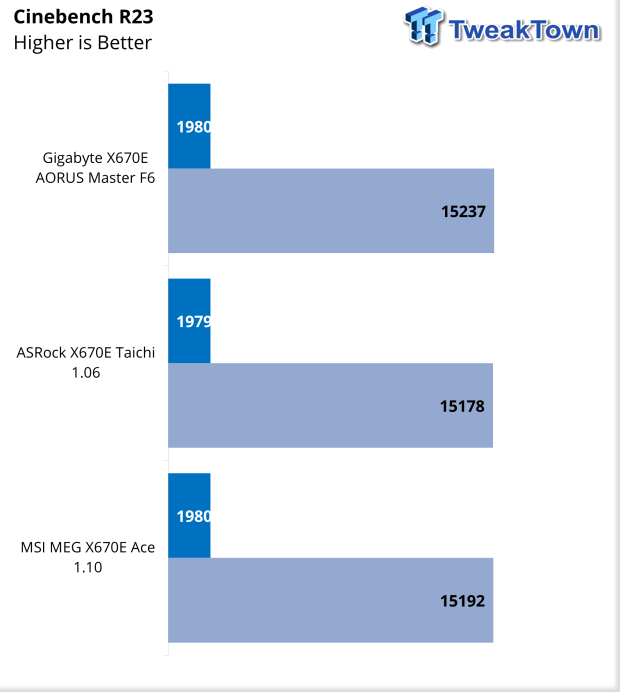
The ACE was tested with BIOS 1.10 for this review. Our first result came from R23 single thread, a score of 1980, on par with past boards. Over to nT or multi-thread, we grab 15192 with our 7700X.
CrossMark
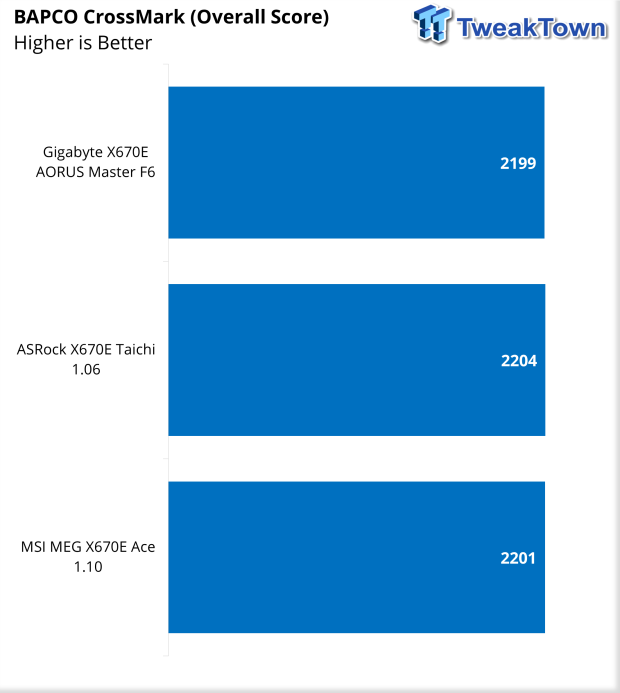
CrossMark landed us an overall of 2201.
AIDA64 Memory
AIDA was recently updated to version 6.6, which improved performance in both AES and SHA3 workloads.
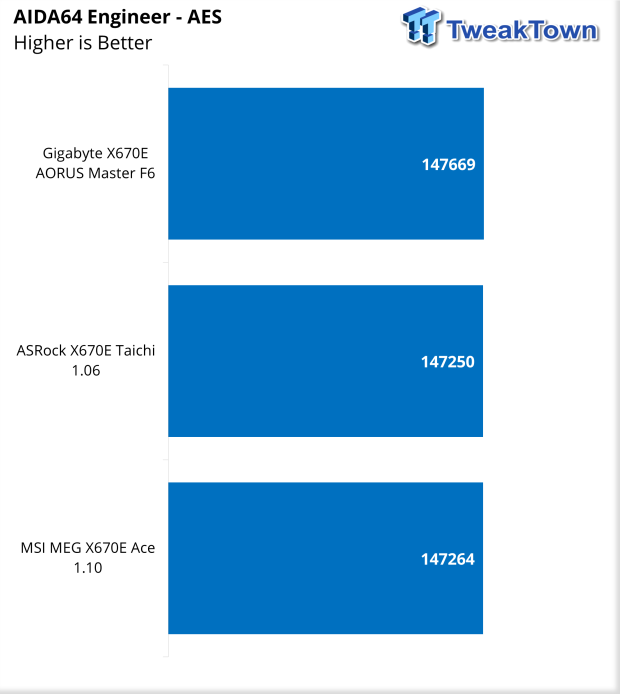
In AES, we picked up 147264 with the ACE.
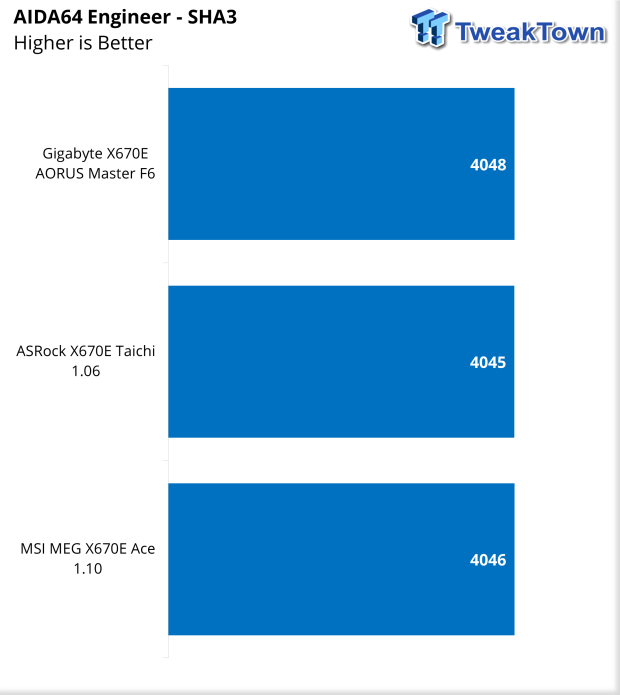
SHA3 tapped in at 4046.
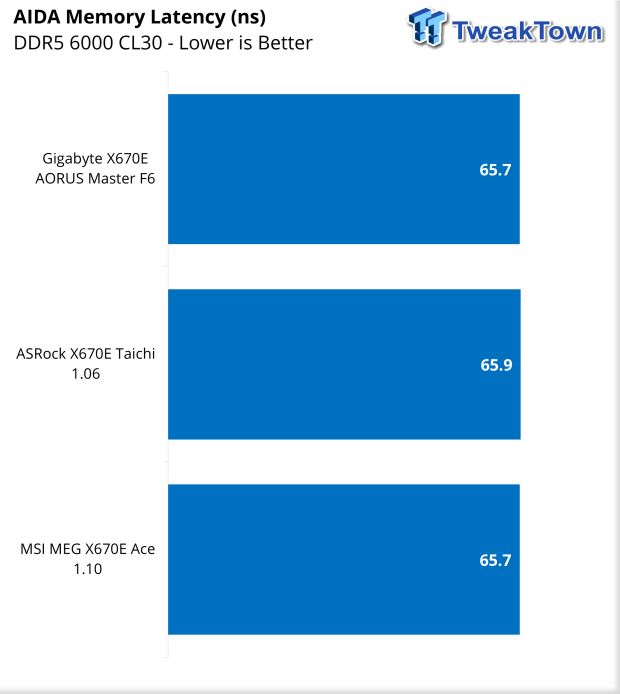
Memory latency was on par with the AORUS Master with a time of 65.7ns.
UL Procyon,3DMark, and CrossMark Benchmarks
UL Procyon Suite
The UL Procyon Office Productivity Benchmark uses Microsoft Office apps to measure PC performance for office productivity work.
The Photo Editing benchmark uses Adobe Lightroom to import, process, and modify a selection of images. In the second part of the test, multiple edits and layer effects are applied to a photograph in Adobe Photoshop.
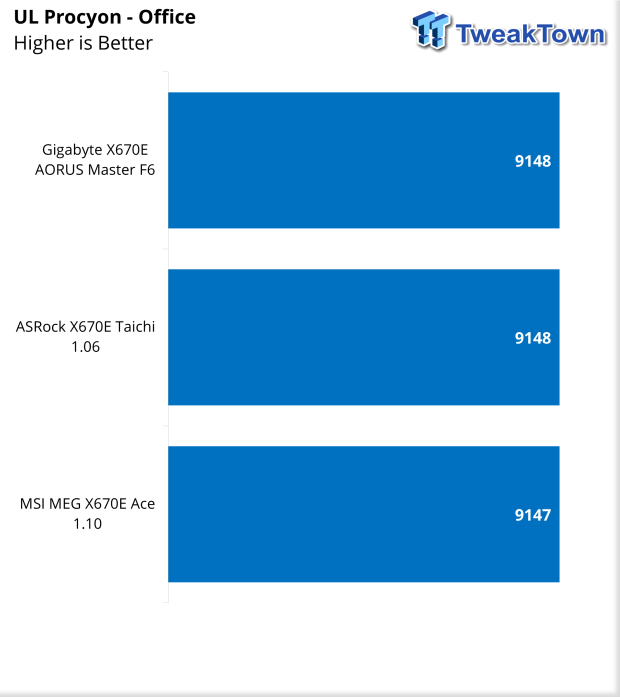
Procyon starts with Office testing, our ACE scoring 9147, on par with others in our charts.
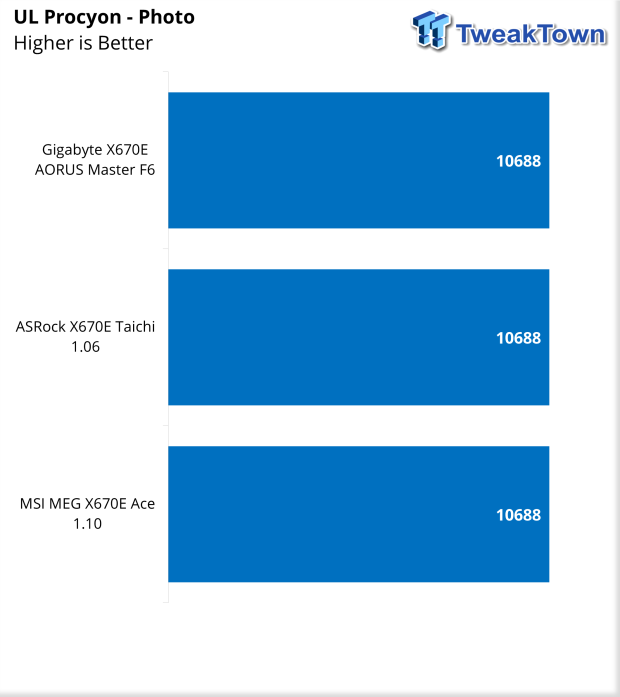
Photo Editing came in at 10688, like past boards.
3DMark
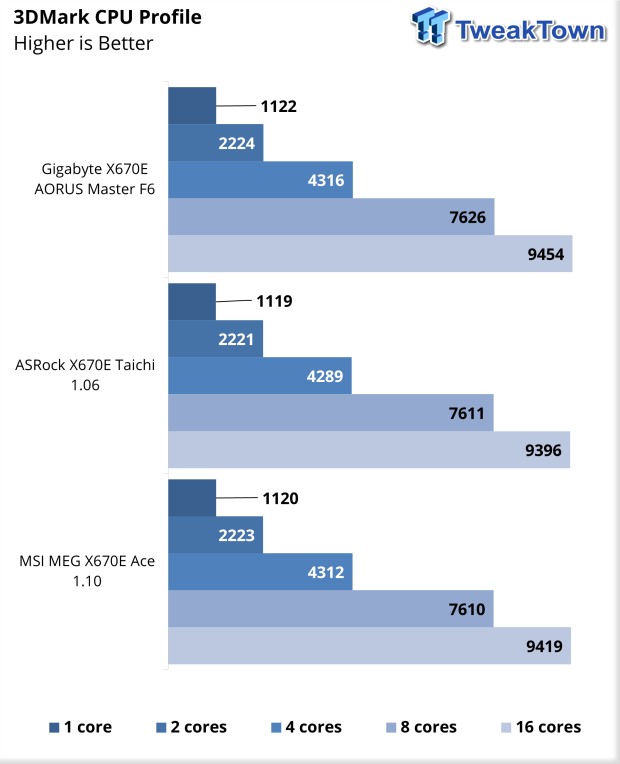
Starting with CPU Profile, the ACE produced a 1120 single thread and 9419 score at sixteen threads.
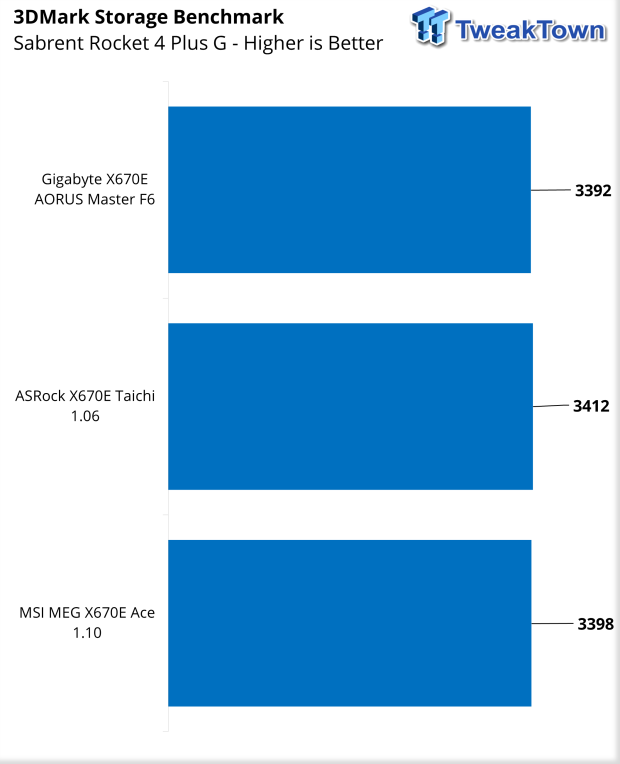
Flipping over to storage, we see a 3DMark score of 3398 from the ACE.
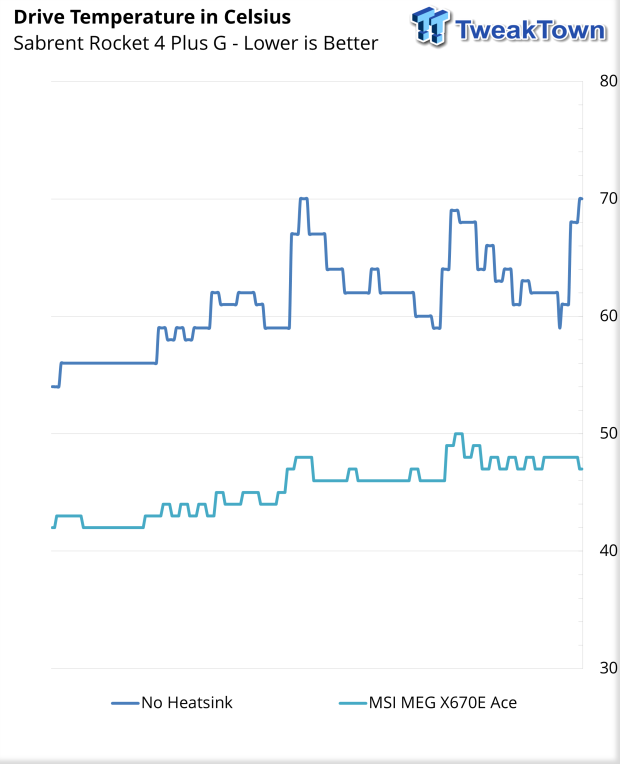
During our storage benchmark testing above, we monitor the temperatures of the Rocket 4 Plus to see how well the motherboard handles the heat load. This will be a crucial part of these boards after Gen5 drives are released with increased heat output.
The ACE did very well, peaking at 50c towards the end of testing.
Gaming Benchmarks and Final Thoughts
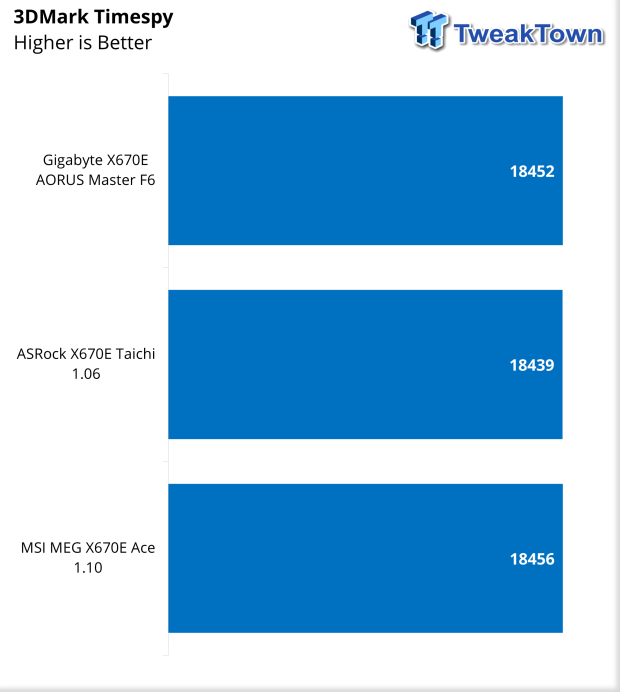
Timespy landed at 18456 with our 3090 Ti.
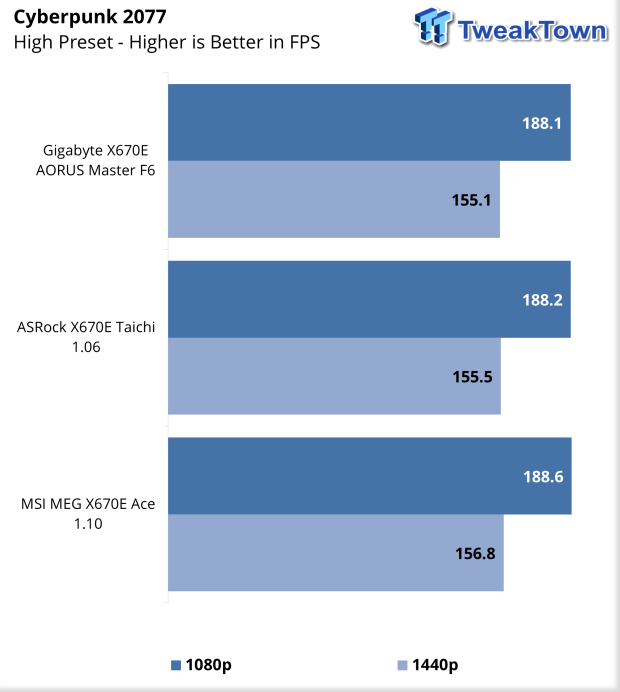
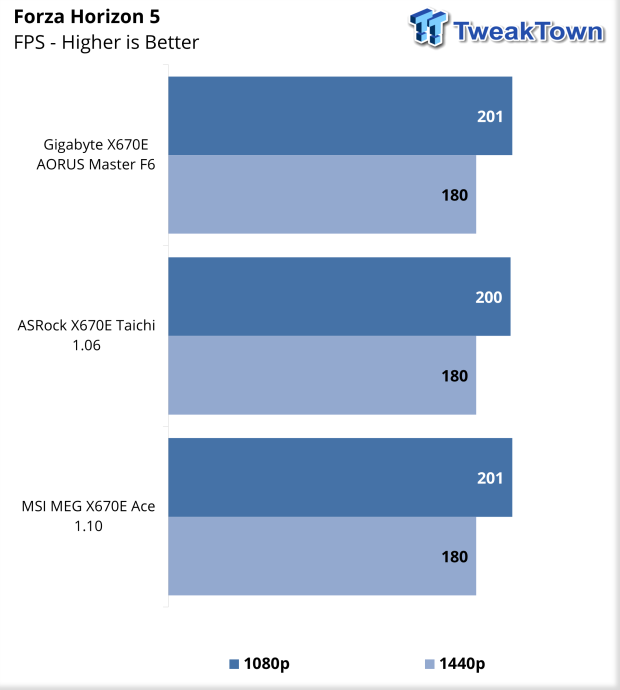
Gaming tests include both Forza Horizon 5 and Cyberpunk 2077. We evaluate both 1080p and 1440p resolutions.
Starting with Cyberpunk, the Taichi picked up a solid 188 FPS at 1080p. This moved to 155 FPS at 1440p. For Forza, we saw 201 FPS at 1080p and 180 FPS at 1440p.
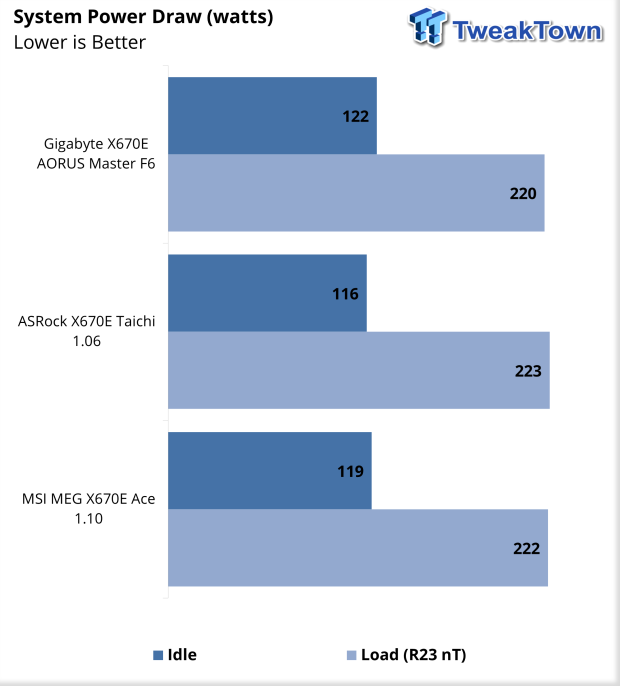
You'll note the data above for those interested in power numbers from our test system.
Final Thoughts
Wrapping up this review, MSI seemingly has the most interesting portfolio, with just two boards occupying the X670E MEG series, their flagship lineup. That said, the ACE is a completely decked out this time around. For enthusiasts, the only thing it is missing is USB4 capability. When we compare this platform to GODLIKE, there isn't much to separate them, leaving me to believe the ACE could be a cheaper iteration of the GODLIKE.
Testing the ACE, we had no issues. In R23, the MSI matched our previous two boards with a single core score of 1980 and multi-thread at 15192. Into Crossmark, the ACE offered a score of 2201, a touch over the Master and just under the Taichi. Real-world workloads showed the Ace matching the Taichi and AORUS Master in Procyon Office and Photo.
Storage testing showed great performance for our Rocket 4 Plus, matching previous boards, while that same testing showed the board's cooling capabilities on slot 1 to be quite good, holding our drive under 50c. Overall power usage was on par with expectations, holding 119 watts at desktop idle while fully loading the CPU pushed it to 222 watts.
Last, we have connectivity, a place where this board shines with a fantastic setup of USB 3.2 ports internally through headers and on the rear I/O where you will find nine Type-A and three USB-C.
What this board does lack is legacy display outputs, offering a single USB-C with DP connectivity, meaning anyone wanting to use this port to push out their Zen 4 Radeon Graphics will need a dongle or new cable to bridge the interfaces.

